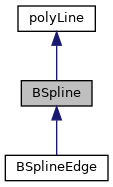An implementation of B-splines. More...


Public Member Functions | |
| BSpline (const pointField &knots, const bool notImplementedClosed=false) | |
| point | position (const scalar lambda) const |
| point | position (const label segment, const scalar lambda) const |
| scalar | length () const |
 Public Member Functions inherited from polyLine Public Member Functions inherited from polyLine | |
| polyLine (const pointField &points, const bool notImplementedClosed=false) | |
| polyLine (const point &start, const pointField &intermediate, const point &end, const bool notImplementedClosed=false) | |
| const pointField & | points () const noexcept |
| label | nSegments () const noexcept |
| point | position (const scalar) const |
| point | position (const label segment, const scalar) const |
| scalar | length () const noexcept |
Additional Inherited Members | |
 Static Public Member Functions inherited from polyLine Static Public Member Functions inherited from polyLine | |
| static tmp< pointField > | concat (const point &start, const pointField &intermediate, const point &end) |
 Protected Member Functions inherited from polyLine Protected Member Functions inherited from polyLine | |
| void | calcParam () |
| label | localParameter (scalar &lambda) const |
 Protected Attributes inherited from polyLine Protected Attributes inherited from polyLine | |
| pointField | points_ |
| scalar | lineLength_ |
| scalarList | param_ |
An implementation of B-splines.
In this implementation, the end tangents are created automatically by reflection.
In matrix form, the local interpolation on the interval t=[0..1] is described as follows:
P(t) = 1/6 * [ t^3 t^2 t 1 ] * [ -1 3 -3 1 ] * [ P-1 ]
[ 3 -6 3 0 ] [ P0 ]
[ -3 0 3 0 ] [ P1 ]
[ 1 4 1 0 ] [ P2 ]
Where P-1 and P2 represent the neighbouring points or the extrapolated end points. Simple reflection is used to automatically create the end points.
The spline is discretized based on the chord length of the individual segments. In rare cases (sections with very high curvatures), the resulting distribution may be sub-optimal.
A future implementation could also handle closed splines.
|
explicit |
| Foam::point position | ( | const scalar | lambda | ) | const |
Definition at line 38 of file BSpline.C.
References lambda(), polyLine::localParameter(), Foam::constant::physicoChemical::mu, and polyLine::points().
Referenced by BSplineEdge::position().


| Foam::point position | ( | const label | segment, |
| const scalar | lambda | ||
| ) | const |
Definition at line 57 of file BSpline.C.
References Foam::constant::physicoChemical::mu, p0, and points.
| Foam::scalar length | ( | ) | const |
Definition at line 127 of file BSpline.C.
References NotImplemented.
Referenced by BSplineEdge::length().

Copyright © 2011-2018 OpenFOAM | OPENFOAM® is a registered trademark of OpenCFD Ltd.